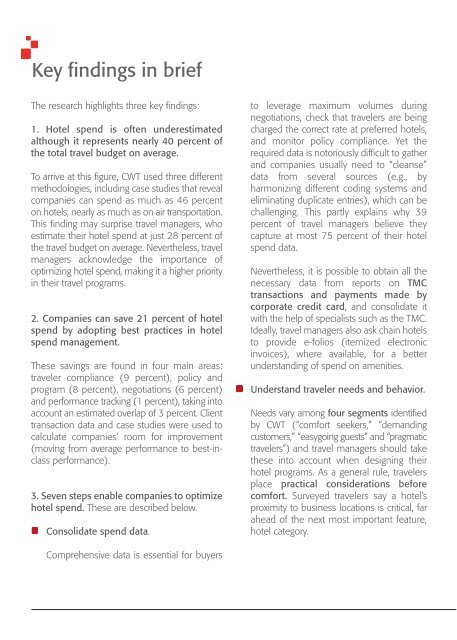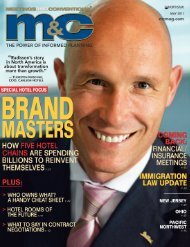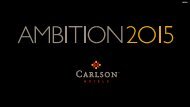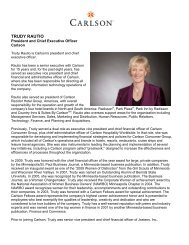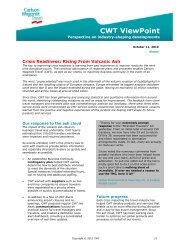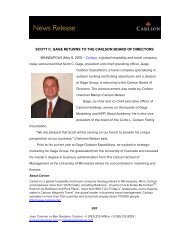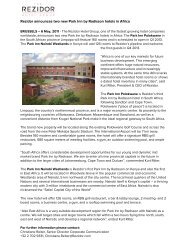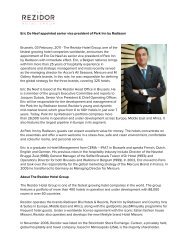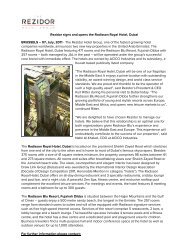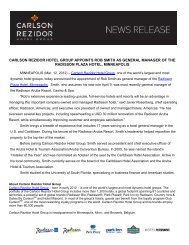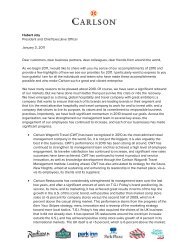Room for Savings: Optimizing Hotel Spend - Carlson
Room for Savings: Optimizing Hotel Spend - Carlson
Room for Savings: Optimizing Hotel Spend - Carlson
Create successful ePaper yourself
Turn your PDF publications into a flip-book with our unique Google optimized e-Paper software.
Key findings in brief<br />
The research highlights three key findings:<br />
1. <strong>Hotel</strong> spend is often underestimated<br />
although it represents nearly 40 percent of<br />
the total travel budget on average.<br />
To arrive at this figure, CWT used three different<br />
methodologies, including case studies that reveal<br />
companies can spend as much as 46 percent<br />
on hotels, nearly as much as on air transportation.<br />
This finding may surprise travel managers, who<br />
estimate their hotel spend at just 28 percent of<br />
the travel budget on average. Nevertheless, travel<br />
managers acknowledge the importance of<br />
optimizing hotel spend, making it a higher priority<br />
in their travel programs.<br />
2. Companies can save 21 percent of hotel<br />
spend by adopting best practices in hotel<br />
spend management.<br />
These savings are found in four main areas:<br />
traveler compliance (9 percent), policy and<br />
program (8 percent), negotiations (6 percent)<br />
and per<strong>for</strong>mance tracking (1 percent), taking into<br />
account an estimated overlap of 3 percent. Client<br />
transaction data and case studies were used to<br />
calculate companies’ room <strong>for</strong> improvement<br />
(moving from average per<strong>for</strong>mance to best-inclass<br />
per<strong>for</strong>mance).<br />
3. Seven steps enable companies to optimize<br />
hotel spend. These are described below.<br />
Consolidate spend data.<br />
to leverage maximum volumes during<br />
negotiations, check that travelers are being<br />
charged the correct rate at preferred hotels,<br />
and monitor policy compliance. Yet the<br />
required data is notoriously difficult to gather<br />
and companies usually need to “cleanse”<br />
data from several sources (e.g., by<br />
harmonizing different coding systems and<br />
eliminating duplicate entries), which can be<br />
challenging. This partly explains why 39<br />
percent of travel managers believe they<br />
capture at most 75 percent of their hotel<br />
spend data.<br />
Nevertheless, it is possible to obtain all the<br />
necessary data from reports on TMC<br />
transactions and payments made by<br />
corporate credit card, and consolidate it<br />
with the help of specialists such as the TMC.<br />
Ideally, travel managers also ask chain hotels<br />
to provide e-folios (itemized electronic<br />
invoices), where available, <strong>for</strong> a better<br />
understanding of spend on amenities.<br />
Understand traveler needs and behavior.<br />
Needs vary among four segments identified<br />
by CWT (“com<strong>for</strong>t seekers,” “demanding<br />
customers,” “easygoing guests” and “pragmatic<br />
travelers”) and travel managers should take<br />
these into account when designing their<br />
hotel programs. As a general rule, travelers<br />
place practical considerations be<strong>for</strong>e<br />
com<strong>for</strong>t. Surveyed travelers say a hotel’s<br />
proximity to business locations is critical, far<br />
ahead of the next most important feature,<br />
hotel category.<br />
Comprehensive data is essential <strong>for</strong> buyers


